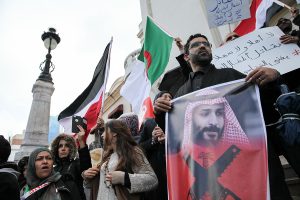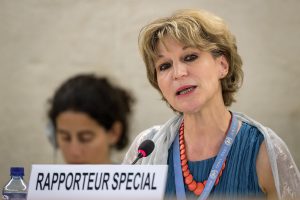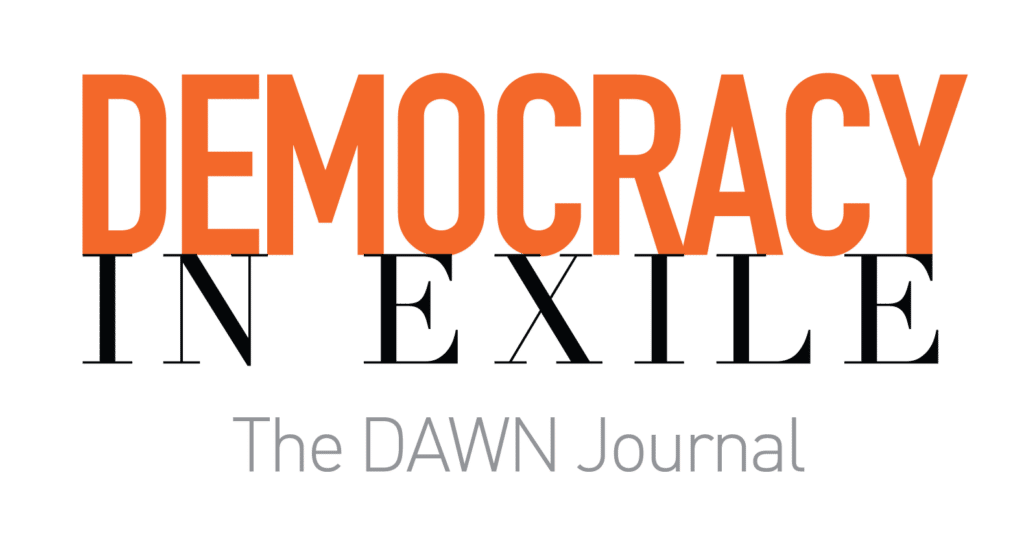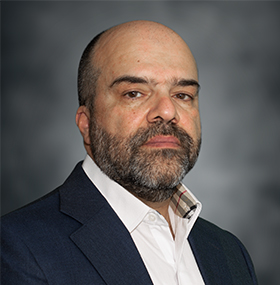Hamzeh Hadad is an Iraqi researcher and political analyst. He is a visiting fellow at the European Council on Foreign Relations and an adjunct fellow at the Center for a New American Security.
Israel's war in Gaza is fueling more conflict across the Middle East, with Israel and Iran's long "shadow war" breaking out into the open and threatening a wider regional escalation. Following Israel's bombing of the Iranian consulate in Damascus, which led to Iran's first-ever direct retaliation against Israel in a barrage of drones and missiles, there are fears of a continuous cycle of escalation, with Israel and the United States on one side and, on the other, Iran and the various armed groups it supports, from Hezbollah in Lebanon to paramilitaries in Iraq.
These tit-for-tat attacks have reanimated a sect-based understanding of the region, centered around a simplistic description of so-called "Iranian-backed Shia groups." This framing not only overlooks the structural causes of conflict in the Middle East—a legacy of colonialism and foreign intervention—but also ignores the complexity of religion in the region. By assuming that groups should be identified by their sect, it suggests that they are driven by ideology and identity, detracting from their primary security and strategic motivations. For example, in understanding the roots of Hezbollah as a militia fighting the Israeli occupation of South Lebanon, with the backing of Iran's Revolutionary Guards, the religious identity of South Lebanon as predominantly Shia should be secondary to the fact that it borders Israel, which occupied it for 17 years and has had a prior history of territorial expansion.
Nevertheless, this religious-based framework prevails in media discourse about Hezbollah and other Shia armed groups. The danger of this framing is that it implicates and typecasts a large and multilayered religious community. Moreover, it overlooks the fact that support for the Palestinian cause is a cross-sectarian issue, not a simple card played by Iran through its proxies and allies.
This narrow view of seeking to understand regional developments primarily through religion is hardly new. In Covering Islam, the late Edward Said critiqued the eagerness with which American media liked to point out the religious identity of groups rather than admitting that various conflicts are rooted in often mundane and familiar power struggles that do not require a dominant religious lens to explain them. This is especially true of how the American media and U.S. policymakers have treated Iraq, a large and diverse country that is nevertheless reduced to a one-dimensional relationship with Iran.
Support for the Palestinian cause is a cross-sectarian issue, not a simple card played by Iran through its proxies and allies.
- Hamzeh Hadad
I tried to correct this simplification in a recent policy paper that I published with the European Council on Foreign Relations. In the paper, I dissected the many aspects of the relationship between Iraq and Iran, focusing on security, politics, and economics—arguing that Iraq is not without its own leverage and authority over Iran. The paper explores how Iraq's political institutions have not, in fact, privileged Iranian interests across the board and that even Shia Islamist figures have vacillated in their support of Iran. In the economic realm, Iraq wields influence over Iran, whose access to global financial networks is restricted under American sanctions.
An important aspect of Iraqi-Iranian relations that the paper only briefly alludes to is the relationship between Shia religious institutions, specifically between the seminaries in both countries that are pillars of Shia theology. This relationship is frequently mischaracterized as both political and as dominated by Iran, perhaps due to the fact that religious and political institutions overlap in the Islamic Republic of Iran. However, even within Iran, the presence of dissenting and apolitical clerics and religious institutions is belied by media representations of Iran's political system as a theocracy run by caricatured "ayatollahs" and "mullahs." This framing denies the existence of an independent Iraqi Shia religious establishment, which enjoys significant moral authority not only within Iraq but also transnationally.
Religious bonds between Iraq and Iran are part of a rich and intricate relationship among Shia clerics, seminaries and peoples going back centuries. Pilgrims have flocked from the holy shrines of Najaf and Karbala, in Iraq, to Qom and Mashhad, in Iran, for hundreds of years. In that time, religious scholars have established important Shia seminaries in those shrine cities, with clerics traversing between them. Histories and religious cultures intertwine. The medieval Persian scholar Abdul Qadir Gilani, the founder of a prominent Sufi mystic order, is buried in central Baghdad, while the Abbasid caliph Harun al-Rashid—Baghdad's most famous ruler—is buried at the shrine of the eighth Shia Imam, Ali al-Rida, in Mashhad.
Iraq's most prominent seminary, established in the 11th century, is in Najaf, led by Grand Ayatollah Ali al-Sistani. Traditionally, Najaf's seminary has welcomed thousands of Iranian scholars, including Ayatollah Ruhollah Khomeini himself between 1965 and 1978. In return, the seminary in Qom has also served as a refuge for many Iraqi clerics, particularly those who sought to escape persecution of the Ba'ath Party under Saddam Hussein in the 1980s and 1990s. Despite this exchange and traffic between the two seminaries, their distinctive intellectual identities within Shia theology have remained firm.
Moreover, research has demonstrated that the seminary in Najaf has always been ethnically and nationally mixed, and even more so after the American invasion of Iraq in 2003. The seminary's most prominent ethnic group, aside from Arabs, is Persians. In fact, most heads of Iraq's religious establishment have been ethnically Persian, including Grand Ayatollah Sistani, who has been described as "patriotic" to Iraq and supportive of democracy by various scholars. This demonstrates the institutional strength of the Najaf seminary, which is enriched by the different ethnic and national backgrounds of its members.
There are also questions about the strength of clerical influence on society, in both Iraq and Iran, as the unpopularity of clerics has grown, largely due to any perceived connections to political life and a popular rejection of religion in politics by protest movements. However, more recent research on Shia clerical influence in Iraq suggests that the religious establishment's influence on adherents in Iraq, while waning, has in fact plateaued in recent years. The Iranian case is more complex, as the post-1979 order following the Islamic revolution expressly merged religion and politics. This was not the case in post-2003 Iraq, despite the role of Grand Ayatollah Sistani in the post-Saddam political transition under American occupation.
In Iran, though, Supreme Leader Ali Khamenei's religious credentials have been a frequent target of criticism among Shia clerics in the past, with many senior scholars viewing him as succeeding Khomeini purely on political and strategic grounds, rather than scholarly merit. Although Khamenei has since addressed his scholarly deficits by learning under the late Ayatollah Mahmoud Shahroudi, he still does not enjoy the adherence of the entirety of Iran's Shia population. According to a 2016 survey of Shia pilgrims from Iraq and Iran, the overwhelming majority of Iraqis emulate Grand Ayatollah Sistani and most Iranians emulate Khamanei, but Iranians are much more likely to emulate alternate clerics than Iraqis. In other words, the religious influence of Khamenei's outreach over Shia adherents is overstated and conflated with his political power.
There are also clear limits to Iran's influence over Iraq's clerical establishment. Tehran has tried to shape the successorship to Sistani in its favor, albeit unsuccessfully. It was no secret that Iran's leadership promoted the late Ayatollah Shahroudi for many years as Sistani's eventual replacement—so much so that the last time Shahroudi visited Iraq before he died in 2018, Sistani refused to meet with him. No official reason was given by Sistani's office at the time, but many suspected it was displeasure with Shahroudi's attempts to seek leadership of Najaf's seminary when tradition has dictated that Sistani have a primary role in hinting at his successor. This is not the first time—nor will it be the last—that external actors try to influence the religious leadership in Najaf. Saddam Hussein's Ba'athist regime attempted, and failed, to groom an "Arab" successor to Grand Ayatollah Abu al-Qasim Khoei, who died in 1992.
In some instances, Iranian dissident clerics and NGOs have even appealed to Sistani on occasion to intervene against Khamenei, most recently during the anti-government protests that swept across Iran in 2022. If these reports are true, they are not surprising, given that even Khomeini himself did not enjoy the full-throated support of Iran's clergy.
It may be convenient to assign a label of Iranian-backed or Shia (or both) to the various groups who proclaim to defend the Palestinian cause, but that is neither correct nor comprehensive.
- Hamzeh Hadad
There are political issues, however, like Palestine, where clerics from both countries see eye-to-eye. Letters exchanged in 1979 between Ayatollah Khomeini and Ayatollah Muhammed Baqir al-Sadr—the revered Iraqi cleric who was executed by Saddam Hussein's regime in 1980—expressed anger over Israel's occupation. More recently, when Pope Francis visited Iraq in March 2021, in his meeting with Sistani, the Grand Ayatollah raised his concerns about "the Palestinian people in the occupied territories."
The seminaries of Najaf and Qom reflect the complexity of the ties between Iraq and Iran. These two centers of Shia theology are neither antagonistic actors nor political rivals, but instead intellectual competitors that have different political interests. Like broader relations between Iraq and Iran, the issue of Palestine is a matter of alignment between these two religious institutions, rather than of Iranian influence—just as Palestine is a matter of alignment for so many communities, movements and groups across the Middle East with different religious, ethnic and political identities. What unites them is their deep sympathy and solidarity with the suffering of Palestinians.
Ultimately, it is important to remember that support for Palestine, whether in Iraq, Lebanon, or elsewhere, should not be understood within a religious framework, as it is a cross-sectarian issue that binds diverse actors across the region. It may be convenient to assign a label of Iranian-backed or Shia (or both) to the various groups who proclaim to defend the Palestinian cause, but that is neither correct nor comprehensive. One need look no further than the complicated relationship between the Shia religious institutions of Iraq and Iran.






































